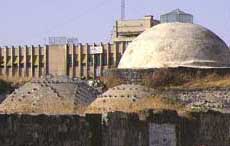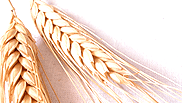 |
 |
| |
Some of the archaeological sites are:

The old Roman bathhouse
The Roman bathhouse: It is famous for its
domed ceilings and their glass windows, which
allow light to come through from sunrise to sunset.
The clay tubes, which were used to carry water
to the bathhouse from a neighboring water spring,
are still in good conditions. The bath- house
contains several apartments and long corridors.
It was renovated by the Ayyubid ruler Shirko
.Water canals: built at the Roman time.
The canals formed an advanced network to distribute
water to the whole city and other close cities
such as Hama and Afamia, which helped the whole
area to fertilize. Roman had excavated and hollowed
out rocks and ground forming these canals, which
almost reach to 360 canals. People in Salamieh
were able to spout out 120 canals out of the 360
including " Alkana Albayda, 3een Al Zarka,
Alghandoria, Alsabeel and others.
Tel Al- Ghazaleh: is believed to be an old
human settlement. It contains several old tombs.
The sulphur water spring at the bottom of the
Tel was used for treating various ailment.
|
|
 |
People
People in Salamieh are very welcoming and warm hearted.
Majority are educated and open minded towards other
nations, culture, and religions. |
| |
|
 |
|
Writers from Salamieh
·Mohammed
Al Maghout
-Anwar al Jumdi
-Fayez Khadoor
-Sma'el Al Amood
-Hussam Khadoor
|
| |
|
|
|
 |
Name History of Salamieh
|
|
There are different theories about the origin of Salamieh's
name, some of them are:
Salamias: This is the name it was known for
at the Romans, Greek, and Palmyrian times. It is said
that the name came to perpetuate Salamias battle between
the Greek and Persians, which Greek won on 480 B.C.
Some say it took the name of the Catholics Bishopric,
which existed in that area at the Akkadian times.
Salam Ma'a: which means in Arabic (a hundred
saved).
Yakoot Al Hamoye mentioned in his book (Mo3jam Al Boldan)
that the name "Salamieh" came from Salam Ma'a
compared to the hundred men who escaped from the Al
Mo'otafeka and came to Salamieh and build it.
Sail Ma'a: which means (water flow). Because
of Salamieh's geographical location, it was exposed
to floods and water overflow coming from the mountains
that surrounded it.
All of the above reasons may sound logical, however
most researchers agreed on Salamias.
|
Hamam(Roman Bathhouse)
Columns of salamieh's old castle
old mail box
Architecture
images sent by Yammen Farha
Image from google search
image from google search
image from google search
shmeimis
Friends of Salamieh.com:
Thank you Loay Shakra for sending Shmeimis picture which is at Salamieh's main page.
Thank you Zeus, Nova, Hanan, Khaled, Ghareeb, Annour, Ruba, Zura, Aloshi, Hasan, Salmonie Tiger and Dr.Salmonie, Abbas, Eihab Al Debiat, Lilian and all the people who post messages...you are all wonderful.
|
 |
 |
| Salamieh is an agricultural city. It is
one of the best syrian cities in producing
grain, cotton, onion, and olives. It has the
only onion's factory in Syria, where onion
is dried up, packaged, and exported to all
Arab countries. |
| |
Shmeimis citadel: located
at the north west of Salamieh city. Some of
its ancient monuments are: a trench that surrounds
the citadel, a wide opened well, and some
watchtowers. The name of the citadel derived
from the name of the Roman Leader "Shmesghram".
It was rebuilted by the Ayyoubian on 1320.
Only ruins remain telling the history of this
citadel....
to the east of the castle and on the top of
one of Al Ala's mountains' series, Gorgeious
monastery exists, which nowadays called
Al Khoder . Parts of Al Khoder basaltic
spiral columns, and decorated walls still
exist. |
| |
|
|
|
|

